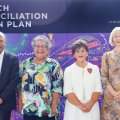Australian children get top marks for geography: UQ study
The English may call Australia "the land down under" but when it comes to geography our kids are on top, according to a University of Queensland study.
Psychology Department Associate Professor Michael Siegal and Professor George Butterworth from the School of Cognitive and Computing Sciences at the University of Sussex conducted a comparative survey of the basic geographical and astronomical knowledge
of Australian and English children.
Funded by a $13,000 Australian Research Council small grant and by support from the Anglo-Australian Scientific Exchange Scheme of the Royal Society of London, the first part of the ongoing study examined children's grasp of scientific concepts and involved interviews with 66 children from Brisbane and 73 children from Newhaven, Sussex, all aged between four and eight.
The study has recently extended to include children from Norway and immigrant Indian families in England.
The researchers found the Australian children to be considerably in advance of their English counterparts when it came to geographical and astronomical information and attributed the differ-
ence to Australia's immigrant culture.
"Almost 100 percent of the Australian children thought the world was round whereas a fifth of English four to eight-year-olds thought it was flat," Dr Siegal said.
"Many of the English group also believed you could only live on top of the world and would Ofall off' elsewhere whereas only the youngest of the Australian sample thought this could happen.
"Unlike the English group, the Australian children more often understood about the day/night cycle - if it was dark on one side of the world, it was light on the other. Similarly, most of the Australian children knew that the Earth moved around the sun
rather than the other way around."
Dr Siegal said culture exerted an important influence on children's understanding of science - the differences between the two groups' knowledge could stem from Australia's immigrant history.
"Our remoteness from big population centres in the northern hemisphere might contribute to the need to comprehend elementary geography. Children are exposed to more maps and globes in the Australian media for example," he said.
"Similarly, many Australian families retain strong connections to the northern hemisphere and endeavour to inform their children about these links from an early age."
Professor Butterworth said the differences between the two groups suggested geographical and astronomical knowledge was a form of "situated cognition" and it depended on the context in which it was acquired.
"At an early age, Australian children are exposed to a great deal of information about their geographical situation and this exposure accelerates the process whereby their intuitive grasp of geography and astronomy is replaced by conventional scientific
wisdom," he said.
For more information, contact Dr Siegal (telephone 3365 6375) or the University's Developmental Psychology Laboratory (telephone
3365 6400).
09/04/97



